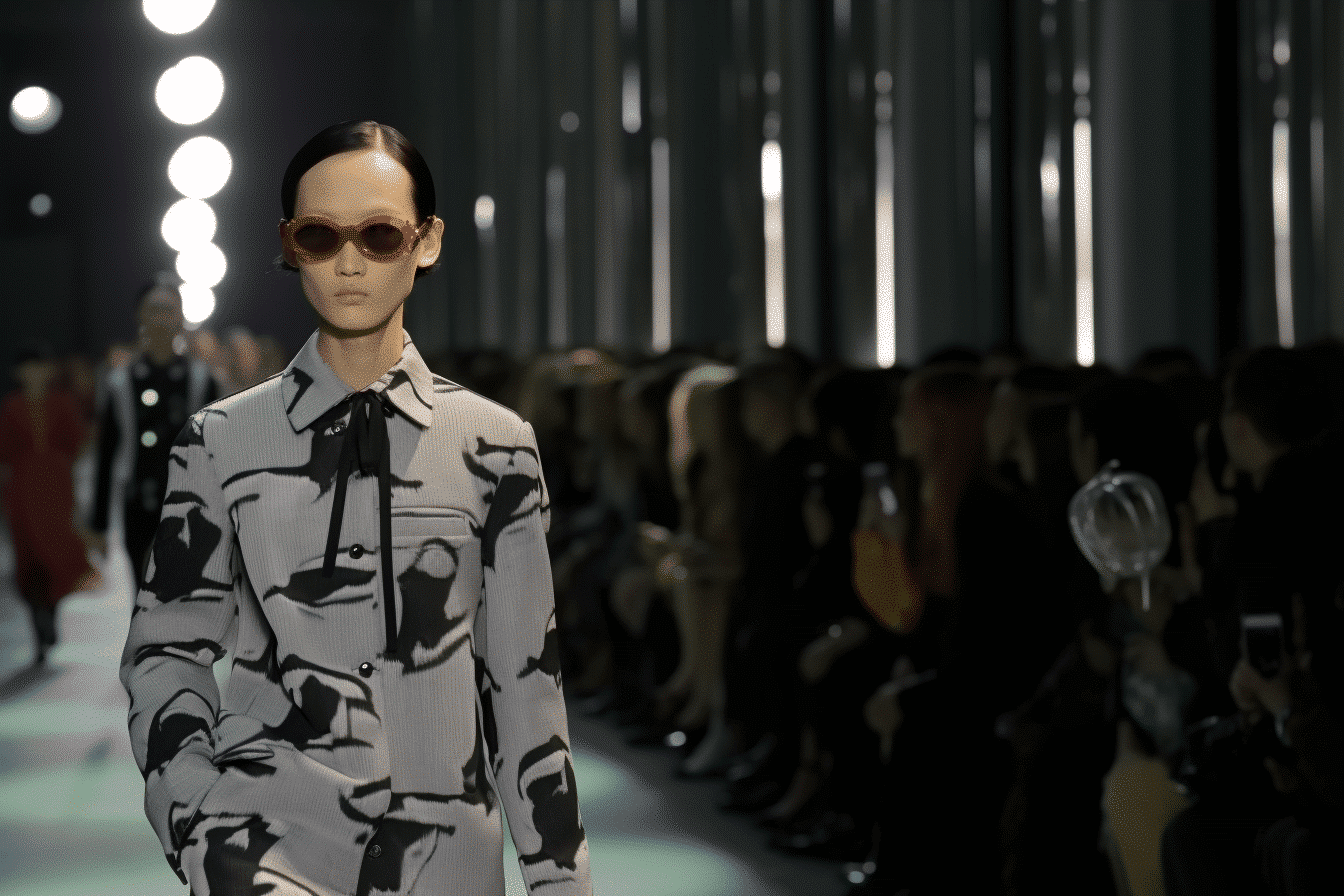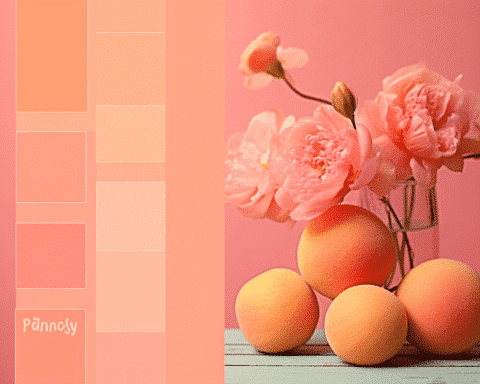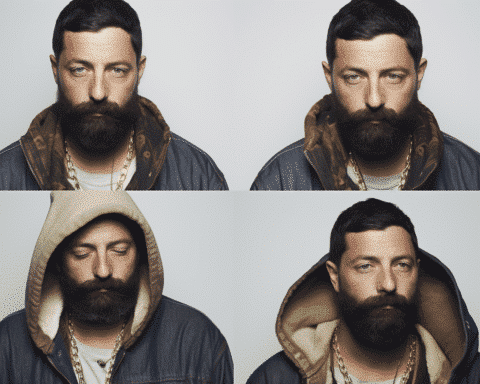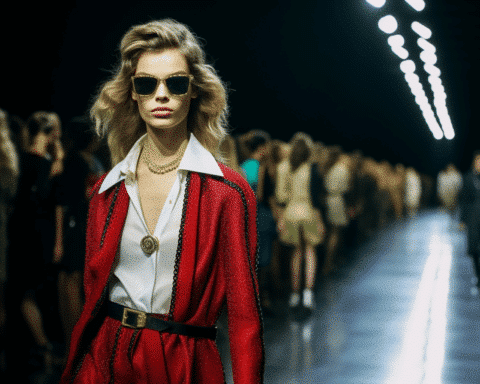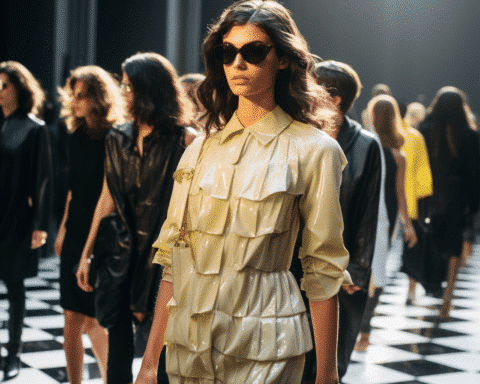The ambiance in Prada’s showroom transforms with each season, but the Spring-Summer 2024 menswear showcase was incredibly unique in its fluidity.
The collection was showcased behind a wall of falling transparent slime, which created a fluid architectural aesthetic as it collected on the metallic grate runway in mounds of green foam. This moving architecture metaphorically expressed the fluidity of menswear the collection aimed to capture.
Highlights from the third day of Milan Fashion Week, primarily featuring menswear runway shows for the upcoming spring and summer, include:
PRADA: A JOURNEY THROUGH FLUIDITY
Prada journeyed through the fluidity of menswear, using a 1940s workwear-tailored silhouette that was simultaneously liberating.
Co-creative directors Miuccia Prada and Raf Simons experimented with fluid architecture to animate the male form without constraints.
The cornerstone pieces of the collection are the white shirt, mid-thigh shorts, black socks, and shiny loafers with thick soles. The range, suitable for everyday men, includes jeans, blazers, and raincoats. The outfits can be layered with a reporter’s vest, and leather bags, soft with decorative pockets, complement the looks.
The textiles are incredibly lightweight, allowing for the neat tucking of button-down shirts or jackets into shorts. The shorts, cinched at the waist, highlight an idealized male form with broad shoulders and a narrow waist.
“We were very interested to see how we could liberate that, in the sense you had a lot of freedom to move,’’ said Simons.
A Hawaiian-inspired print featuring sci-fi dragons added movement with its long fringe. The designers noted that the reporter’s vest had more decorative than practical pockets. Finished looks included moulded eyewear and headbands, projecting kinetic energy.
CHARLES JEFFREY LOVERBOY PITCHES A NEW CAROLEAN ERA
British designer Charles Jeffrey pitched a vibrant Loverboy collection for a new Carolean era in Britain, inspired by the public and the chaotic season of King Charles III’s ascension amidst political strife.
“I wanted to reclaim that space. I decided to do my counterculture,’’ Jeffrey explained backstage. “I looked at the previous Carolean era of the 17th century: the reformation of the monarchy, the opening of theatres, arts and culture, new Romanticism.”
Echoing the new Romantics, Jeffrey used costume “to portray euphoria, to portray a better life.”
The designer incorporated Loverboy’s design elements of tartan, tailoring, and knitwear with what he termed “joyful slapstick accessories.” The collection included a playful shield and sword decorated with classical figures and tricorn hats adorned with scenes from Carolean theatre using paper dolls.
Outfits included fluorescent yellow bloomers, an AI-created floral patterned maiden’s bustled dress, a knight’s armour translated onto athletic running gear, and a barrel dress made from fabric strips belted together. The brand’s leather claw shoes finished many outfits.
“They depict what the Carolean era should be: Free education, gay rights, women’s rights, free borders,’’ Jeffrey explained backstage.
SIMON CRACKER CONFRONTS FASHION WITH FULL UPCYCLING
Simon Cracker, the upcycled, artisanal brand, unveiled a somewhat rebellious and chaotic collection named “Theoretically,” signifying the moment when everything falls into place.
Simon Cracker welcomes gender fluidity and embraces all body types, as evident from its runway models, all of whom are friends of the brand. Its fundamental identity lies in its punk ethos, a tribute to Vivienne Westwood, and entirely upcycled outfits and accessories designed and created by the brand’s founders, Simone Botte and Filippo Biraghi.
“We used all the materials we didn’t love this season,’’ said Botte, diving into a stockpile of rejected chenille, Lycra, and “nasty prints.”
Dresses were fashioned from men’s shirts. A quilted garment was converted into a funky bolero. Men wore slip skirts with painted button-down shirts adorned with fluorescent beads. Overcoats and T-shirts underwent a solar printing process.
Accessories were completely revamped: footwear was painted or covered with crocheted doilies or green tinsel. This season’s handbags were adorned with dolls, including the briefly famous Blythe doll from the 1970s, now reborn in Simon Cracker.
GERMAN LUXURY BRAND MCM REEMERGES
German luxury leather accessories maker MCM, once known for travel bags for the elite, is reintroducing its product line focusing on fresh consumers, from logo-averse individuals to Generation Z.
MCM had a golden period in the 1990s with celebrity fans like Princess Diana and Michael Jackson, followed by iconic moments in the 2000s such as Beyonce’s customized corset and Billie Eilish’s belt bag.
The brand extends its range to miniature leather goods, treated canvas bags, accessories, and maxi bags with a new subdued laurel motif. The Diamant bag, featuring a pointed arch, can be used as a clutch or cross-body bag and is also available in an oversize version.
The accessory line is being broadened to include sliders and sneakers, also featuring the laurel logo, signifying a shift toward subtle luxury. MCM is venturing into apparel with travel-friendly, wrinkle-free clothes, like a treated canvas miniskirt and jacket for women and a varsity-style jacket for men.
Amid increasing accessory prices in the luxury sector due to inflation, MCM maintains prices below 2,000 euros ($2,192). “It’s a sweet spot left by big luxury producers, who unfortunately had to increase prices,’’ said MCM president and brand officer Sabine Brunner.
The third day of Milan Fashion Week saw various established and emerging designers pushing boundaries with fluidity, history-inspired collections, full upcycling, and brand relaunches. Creativity and innovation were evident from Prada’s liberating 1940s-tailored collection to Simon Cracker’s audacious upcycling. Meanwhile, brands like MCM are reintroducing themselves with a fresh perspective to cater to the evolving consumer market. As these brands continue reinventing fashion, we can only anticipate what they store for future collections.
